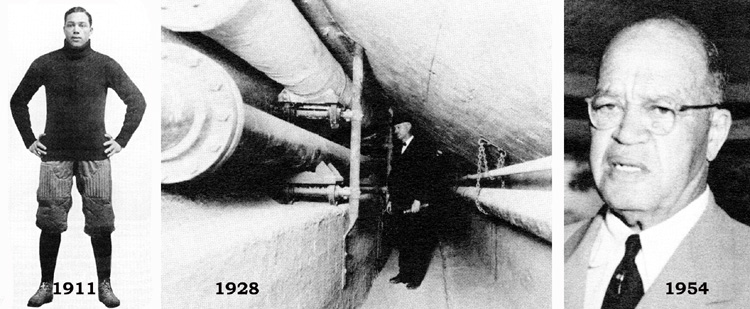Called
“Alexander the Great” by Iowa football fans, Archie Alexander became a
noted design engineer
and presidential appointee during an illustrious career which included
building the heating plant and
steam tunnel at Iowa City’s Burlington Street bridge. Images courtesy State
Historical Society of Iowa
|
By
Bob Hibbs Iowa’s
first black football player – a highly-respected three-year starting tackle
– became a successful design engineer and construction supervisor on
projects which included the University of Iowa heating plant and its steam
tunnel under the Iowa River at Burlington Street. During
an era of blatant racism which including the UI engineering dean telling him
he had never heard of a black engineer, Archie Alexander refused to allow
racial barriers to block success. He overcame regularly; and, became the first
black graduate of the UI College of Engineering. He
went on to an illustrious 42-year career which included building bridges,
railroad trestles, freeways, apartments, airfields and power plants scattered
through most of the 48 continental states. Born
in 1888 in Ottumwa, when he was 11 the family moved to Des Moines, which
Alexander called home the rest of his life. After graduating high school in
1905, he attended Highland Park College and the Cummins Art School before
entering UI in 1908. During
his successful college career in Iowa City, he became a strong football player
who was popular with both teammates and fans. While the average player was
5’7” and weighed 135 pounds, Alexander was considered a big man at
6’2” and 177 pounds. During
his last season in 1911, the Iowa-Iowa State game brought a record crowd of
8,000 to the Athletic Park field along the Iowa River north of Burlington
Street. Season tickets were $1.50 for three home games. Upon
graduation in 1912, he took a laboring job at 25 cents an hour in an
engineering steel shop after every engineer in Des Moines refused to hire him
despite good grades and football success. By the time he left two years later
to start his own company, he headed bridge construction field work in Iowa and
Minnesota. While
working at that first job, Alexander had met engineer George Higbee, a white
who in 1917 partnered with Alexander in a venture called Alexander and Higbee.
Eight years later when Higbee was killed in a construction accident. During
1921 Higbee had assumed operation of the firm while Alexander took a refresher
course at the University of London. Alexander
ran the firm alone after his partner’s death. In 1926 he was contracted to
build the UI heating plant, then in 1927 the associated power plant and the
steam tunnel beneath the Iowa River to serve the growing west campus, where
the following year would witness opening of a new University Hospitals
facility. In
1929 a classmate who had become an instructor at the UI college, Maurice
Repass, joined Alexander as a junior partner. That began a long, successful
association during which the firm was renamed Alexander and Repass. In
1949 Ebony magazine described the
Des Moines firm as the nation’s “most successful interracial business.” Although
Alexander moved freely in the white world, he was abundantly aware of racial
problems. He headed the Des Moines chapter of the NAACP, the local
Inter-Racial Commission and as a trustee of both Howard University and the
Tuskegee Institute, two of the nation’s most prestigious black centers of
higher education. He
also lectured regularly at Howard. Alexander,
a life-long Republican, served during the 1930s and early 1940s as assistant
to the chairman of the Iowa GOP. In 1952 his early backing of Dwight
Eisenhower resulted after Ike’s election in an office for this black man
from Iowa – appointment in 1954 as governor of the largely black Virgin
Islands. Alexander
proved ill suited to a political post. His efforts to “help those people get
on their feet” proved a disaster, including serious damage to Alexander’s
health. He resigned after just 16 months, and died of a heart attack in
January 1958. He
bequeathed $200,000 for scholarships to help others. Next
Saturday: The Iowa City Academy
experiment. Bob Hibbs collects local postcards and other historic ephemera and researches history related to them. |
